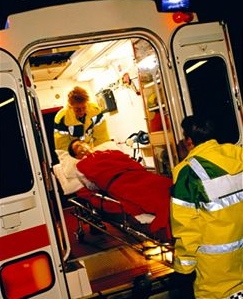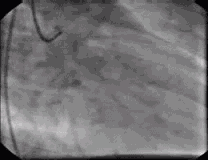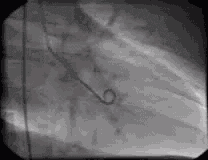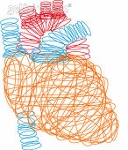
Hospitals and Emergency Medical Technicians (EMTs) have been implementing strategies to decrease door-to-balloon (D2B) time.
Not familiar with D2B? It's the term for the time it takes to get a heart attack victim to the hospital for a cardiac angioplasty procedure (heart cath). Heart catheterization is the insertion of a "balloon" catheter into a chamber or vessel of the heart and is used to reopen blockage and limit the amount of dying heart muscle by restoring blood flow to the heart. Click here if you've had a heart attack.
Emergency Medical Technicians usually make the right call when assessing patients for suspected STEMI, an acronym meaning "ST segment elevation myocardial infarction," a type of heart attack in which the coronary artery is completely blocked. A STEMI is diagnosed by changes in the "ST segment," of an electrocardiogram (ECG) that indicate a large portion of heart muscle death is occurring. In the second type of heart attack, NSTEMI (non-STEMI), the blood clot only partly occludes the coronary artery.

Pictured at left is cardiac catheterization of coronary arteries. Below left cardiac catheterization of the left ventricle of a heart with visible catheter for injection of contrast agent.
Armed with portable ECG results, the EMTs correctly identified STEMI -- and called ahead for cath lab activation -- in 85 percent of nearly 4,000 patients included in an analysis by J. Lee Garvey, M.D., of the Carolinas Medical Center in Charlotte, N.C., and colleagues.
An analysis in 2009 of STEMI networks across the U.S. found that 86 percent of them reached the target of less than 90 minutes from ambulance to cath lab. The goal is to ensure heart attack patients receive treatment in under 90 minutes.

According to research, the improved efficiency may be attributed to the good judgment of EMTs, the ability of EMTs to correctly identify STEMI, and shorten D2B time by two-thirds, according to one study.
Back in the day, it was apparent that heart attack patients needed hospital treatment more quickly than the average six hours it took to get treatment then. There were fewer survivors and, importantly, survivors whose compromised quality of life afterward made their "good luck" at surviving questionable. In 1977, The National Heart Alert Program set goals to:
"Target specific groups of patients: those who are known to have coronary heart disease, atherosclerotic disease of the aorta or peripheral arteries, or cerebrovascular disease. The risk for acute myocardial infarction or death in such patients is five to seven times greater than that in the general population" ... and should be "clearly informed about symptoms that they might have during a coronary occlusion, steps that they should take, the importance of contacting emergency medical services, the need to report to an appropriate facility quickly, treatment options that are available if they present early, and rewards of early treatment in terms of improved quality of life.
These ... patients should be encouraged to have a plan and to rehearse it periodically.
Because of the important role of the bystander in increasing or decreasing delay to treatment, family members and significant others should be included in all instruction. Finally, physicians' offices and clinics should devise systems to quickly assess patients who telephone or present with symptoms of a possible acute myocardial infarction." April 15, 1997, Annals of Internal Medicine.
Remarkably, recommendations in studies like this one in 1997, by Yale University's Angelo A. Alonzo, Ph.D. and colleagues, were put into action and helped bring about the success we are experiencing today. The average time to treatment for a heart attack victim from the site of the heart attack to hospital treatment now averages 60-90 minutes. More deaths are prevented and survivors have better outcomes. Emergency Medical Service Technicians are in large part responsible for the improvement.
The goal of the Yale Heart Study is to duplicate past success by shortening the four hours, on average, a heart attack victim waits at home or work before calling 9-1-1 or getting to a hospital. Survivors who complete the online survey will help develop strategies for encouraging people to get help sooner.
D2B is working. How quickly can we do the same with heart attack-to-door times? 9-1-1 is an inside call -- EMTs can't make them, but you can.
See you tomorrow.
Photos via Getty and Creative Commons
---
 Heart attack survivors, please click here to take the Yale Heart Survey aimed at reducing the time victims delay before calling 9-1-1 or going to the hospital. If you haven't had a heart attack, click and forward to someone who has had one. Thank you.
Heart attack survivors, please click here to take the Yale Heart Survey aimed at reducing the time victims delay before calling 9-1-1 or going to the hospital. If you haven't had a heart attack, click and forward to someone who has had one. Thank you.
Disclosure: Suzanne O'Malley is a Sr. Research Associate for the non-profit NIH-funded Yale Heart Study. Applications are open to her creative & screenwriting weekends & summer classes at Yale Writers' Conference & Yale Summer Film Institute.
For more by Suzanne O'Malley, click here.

